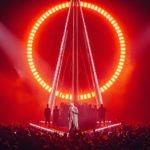“Discovery consists of looking at the same thing as everyone else and thinking something different.” – Albert Szent-Gyorgyi (9/16/1893 – 10/22/1986), Nobel Prize-winning Hungarian physiologist. You’ve seen the purple and orange FedEx logo a million times. Or have you? The next time you see the familiar delivery truck logo, take a close look at the negative space around it. Do you notice anything that you haven’t seen before? If you invert the logo and focus on the negative space, you’ll notice an arrow popping out between the “E” and the “x.” It’s the quintessential subliminal message: Go FedEx.
Why have you never noticed it before? Most of us have become accustomed to looking at our world through old eyes. We tend to focus on what’s eminently obvious, and we are often completely oblivious to much of our surroundings. We tend to look not at the negative space, but the more dominant positive space of the logo. What if we had the ability to see with new eyes? Is there any value in shedding our visual shackles and learning to see from a new point of view? What would you give to be able to look at the same thing everyone else does but come away with a completely unique and different observation? Is that not the very essence of creativity?
Looking at the world from a different angle can give you a new point of view and perhaps some creative insight. For example, if you’re programming a show and you want to create a new look, what might happen if you could see the stage from an upside down point of view? Does that change your perception of the proportion of color combinations? The layout of the stage? You can try standing on your head, but it’s much easier to take a picture and turn it upside down. I’ve tried it both ways and I’m here to tell you, both ways, are equally effective but not always equally practical.
Taking a new physical view is one way of gaining new perspective. I once went to a Dixie Chicks concert where the lighting designer, Roy Bennett, advised me to temporarily abandon the down-front seats he got me and take a look from the cheap seats in the nosebleed section. When I did, then I understood why he suggested it; it was a completely different perspective, and you could see much more than you could from in front of the stage. You could see the colors and patterns in the video floor and how it complemented the lighting and video projection. You could see the entire performance area and the way the production moved between cues. You could see a completely different show. When you’re programming or designing a show, take a stroll in the house and see the show from different perspectives.
Can you completely reverse your thinking? What if you were to look at your work backwards, figuratively speaking? Back lighting is one example of a way to invert the space and swap the positive space for negative space. It can reveal just enough about the subject to present a mystery. It reveals a little about the shape, the form, the movement, but not so much as to reveal everything about it. It leaves something to the imagination.
Some of the most creative people know intuitively how to look at the world from a unique perspective. John Lennon loved to play with words, pictures and music. Once, he took a familiar piece of classical music and turned it around, almost literally, and made it a pop tune. Lennon is quoted in David Sheff’s book, All We Are Saying.
“Yoko was playing Beethoven’s “Moonlight Sonata” on the piano. I said, ‘Can you play those chords backwards?’ and wrote ‘Because’ (Abbey Road, 1969) around them.”
Jimi Hendrix used a form of backwards creativity. In the song, “Are You Experienced”, he played a guitar solo to a backwards track to create a completely new sound.
There are other ways to trade in your old eyes for new. If imitation is the highest form of flattery, find examples of the highest form of creativity and try imitating them. Then heed Albert Einstein’s advice; he said the secret to creativity is knowing how to hide your sources. What better way to gain a new perspective and hide your sources than to imitate two masters and blend the results? If you’re looking for examples of color combinations, check out Peter Max, the master of applying primary colors over large areas to create a signature look. If shapes and patterns are what you’re looking for, look to M.C. Escher. His work is a great source of inspiration for combining forms, patterns and art. Now try combining the two, and applying the results to your lighting and/or set design. Some of the world’s most inspiring art creations come from the combination of two disparate sources. Jazz + rock = Miles Davis and Bitches Brew. Folk + rock = Bob Dylan and Highway 61 Revisited. Little Richard + Elvis = early Beatles. Max + Escher = ?
But if you’re going to trade in your old eyes for new, you have to be willing to take some risk and be unafraid of setbacks or temporary failures. Like a new pair of legs, it might take some time before you’re able to walk comfortably. That’s comes with being a pioneer and breaking new ground. When Noah Schachtman of Wired Magazine interviewed DARPA director Tony Tether about his record of success at the Defense Advanced Research Project Agency, he summed it up in six words: “It’s okay for us to fail.” If it’s good enough for the guys who invented the Internet (of course, they couldn’t have done it without Al Gore), then it’s good enough for me.
You’ve been looking all your life, but only with new eyes can you really begin to see. There is, it seems, more than one way to do it.


